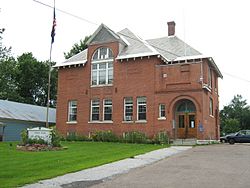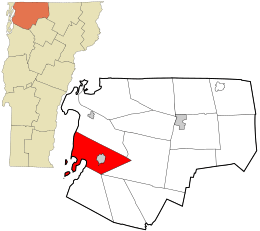St. Albans (town), Vermont facts for kids
Quick facts for kids
Town of St. Albans
|
|
|---|---|

St. Albans Town Hall
|
|

Location in Franklin County and the state of Vermont.
|
|
| Country | United States |
| State | Vermont |
| County | Franklin |
| Community | St. Albans Bay |
| Government | |
| • Type | Selectboard |
| Area | |
| • Total | 60.5 sq mi (156.8 km2) |
| • Land | 37.0 sq mi (95.9 km2) |
| • Water | 23.5 sq mi (60.9 km2) |
| Elevation | 100 ft (30 m) |
| Population
(2020)
|
|
| • Total | 6,988 |
| • Density | 115.43/sq mi (44.566/km2) |
| Time zone | UTC-5 (Eastern (EST)) |
| • Summer (DST) | UTC-4 (EDT) |
| ZIP Codes | |
| Area code(s) | 802 |
| FIPS Code | 50-011-61750 |
| GNIS feature ID | 1462197 |
Saint Albans, often called St. Albans, is a town in Franklin County, Vermont, USA. In 2020, about 6,988 people lived there. The town completely surrounds St. Albans City, which is a separate community.
Contents
History of St. Albans
The town of St. Albans was named after the city of St Albans in England. That English city got its name from Saint Alban, an early Christian saint.
The St. Albans Raid
On October 19, 1864, St. Albans was the site of a famous event during the American Civil War. This was the St. Albans Raid, the northernmost land action by the Confederate army. Confederate soldiers rode in from Quebec, Canada, and robbed banks in the town.
Town and City Separation
The town of St. Albans and the city of St. Albans were once one place. They did not become separate until 1902. Before this date, when people talked about "St. Albans," they usually meant the town center. This area is now part of the city. The town officially became a town in 1859, and the city became a city in 1902.
Fenian Raids and Irish Independence
After the Civil War, some Irish men wanted Ireland to be independent. They launched attacks on Canada, known as the Fenian raids. At least two of these raids happened in 1866, and more in 1870–1871. Men were recruited from places like New York City to St. Albans, Vermont.
A secret agent named Henri Le Caron worked for the British government at this time. He also held a position in the "Irish Republican Army." He claimed to have given many weapons and ammunition to the men preparing for the raids. However, the US General George Meade captured much of these supplies. Many raiders never even made it into Canada. These raids actually helped increase support for the Canadian Confederation. Canadians felt they needed to unite to defend themselves.
St. Albans as the Butter Capital
By the 1890s, the town of St. Albans was very important for farming. It became known as the "butter capital of the world." At that time, it had 1,000 farms and 15,000 cows!
Amelia Earhart's Visit
The famous pilot Amelia Earhart is said to have flown to St. Albans on May 22, 1934. This visit might have been to promote her new line of active wear clothing. She started her clothing line that same year.
Geography and Nature
The town of St. Albans is located in the western part of Franklin County. It stretches west into Lake Champlain, reaching the border with Grand Isle County, Vermont.
Land and Water Areas
The town covers a total area of about 156.8 square kilometers (60.5 square miles). About 95.9 square kilometers (37.0 square miles) is land. The remaining 60.9 square kilometers (23.5 square miles), or 38.84%, is water. The southwest part of the town is on St. Albans Bay, which is an arm of Lake Champlain.
Islands in Lake Champlain
Several islands in Lake Champlain are part of the town. These include Woods Island, Burton Island, and Ball Island.
Population and People
| Historical population | |||
|---|---|---|---|
| Census | Pop. | %± | |
| 1790 | 256 | — | |
| 1800 | 901 | 252.0% | |
| 1810 | 1,609 | 78.6% | |
| 1820 | 1,636 | 1.7% | |
| 1830 | 2,395 | 46.4% | |
| 1840 | 2,702 | 12.8% | |
| 1850 | 3,567 | 32.0% | |
| 1860 | 3,637 | 2.0% | |
| 1870 | 7,014 | 92.9% | |
| 1880 | 7,193 | 2.6% | |
| 1890 | 7,771 | 8.0% | |
| 1900 | 1,715 | −77.9% | |
| 1910 | 1,617 | −5.7% | |
| 1920 | 1,583 | −2.1% | |
| 1930 | 1,691 | 6.8% | |
| 1940 | 1,733 | 2.5% | |
| 1950 | 1,908 | 10.1% | |
| 1960 | 2,303 | 20.7% | |
| 1970 | 3,270 | 42.0% | |
| 1980 | 3,555 | 8.7% | |
| 1990 | 4,606 | 29.6% | |
| 2000 | 5,086 | 10.4% | |
| 2010 | 5,999 | 18.0% | |
| 2020 | 6,988 | 16.5% | |
| U.S. Decennial Census | |||
Population in 2020
In 2020, the town had 6,988 people. Most residents, 96.6%, were White. About 2.0% were Asian, and 0.2% were Black. About 0.1% were Native American. People of Hispanic or Latino background made up 0.1% of the population.
Life in St. Albans (2000 Census)
In 2000, there were 5,086 people living in St. Albans. There were 1,836 households, and 1,404 of these were families. The average household had 2.68 people. The average family had 3.01 people.
About 38.2% of households had children under 18 living with them. Most households (61.6%) were married couples. About 11.1% had a female head of household with no husband present.
The median age in the town was 38 years old. About 27.0% of the population was under 18. About 14.1% were 65 years or older.
Arts and Culture in St. Albans
Annual Bay Day Event
St. Albans town is located right on the shore of Lake Champlain. Every Fourth of July, the town celebrates with a special event called "Bay Day." This event includes a triathlon race and a fantastic fireworks show over the bay.
Getting Around St. Albans
Several main roads serve the town of St. Albans. These highways help people travel to and from the area.
- Interstate 89, with exits 19 and 20
- U.S. Route 7
- Vermont Route 36
- Vermont Route 38
- Vermont Route 104
- Vermont Route 105
- Vermont Route 207
Famous People from St. Albans
Many interesting people have connections to St. Albans. Here are a few:
- Bradley Barlow: A US congressman and businessman.
- William Beaumont: A surgeon who served in the U.S. Army.
- Corydon Beckwith: A justice on the Illinois Supreme Court.
- Paul Blackburn: A well-known poet.
- Lawrence Brainerd: A US senator.
- Richard M. Brewer: Thought to be a leader of Billy the Kid's group.
- Michael J. Colburn: A director of the United States Marine Band.
- Abbott Lowell Cummings: An expert in architectural history and family trees.
- Sile Doty: A famous thief and leader of a criminal group.
- Albert S. Drew: A former mayor of Burlington, Vermont.
- Albert B. Jewett: A commander in the 10th Vermont Infantry Regiment during the American Civil War.
- John LeClair: A professional ice hockey player. He played for the Montreal Canadiens, Philadelphia Flyers, and Pittsburgh Penguins.
- Rod Loomis: An actor.
- William L. Manly: A pioneer author who wrote "Death Valley in '49."
- Sara Weeks Roberts: A president of the National Library for the Blind (United States).
- John Gregory Smith: The 28th governor of Vermont.
- William Farrar Smith: A Union general during the American Civil War.
- Orlando Stevens: A member of the state legislatures in Vermont and Minnesota.
- Benjamin Swift: A US senator.
Champ, the Lake Monster
The famous lake monster "Champ" is said to live in Lake Champlain. Some people claim to have seen and even photographed Champ near St. Albans.
The Story of Champ
The story goes that the French explorer Samuel de Champlain first saw "Champ" in 1609. Champlain founded Quebec City and the lake is named after him. He was supposedly fighting the Iroquois on the lake's bank when he saw the creature. However, there is no actual record of Champlain seeing such a monster. This story was traced back to an article written in 1970.
See also
 In Spanish: St. Albans (pueblo en Vermont) para niños
In Spanish: St. Albans (pueblo en Vermont) para niños

